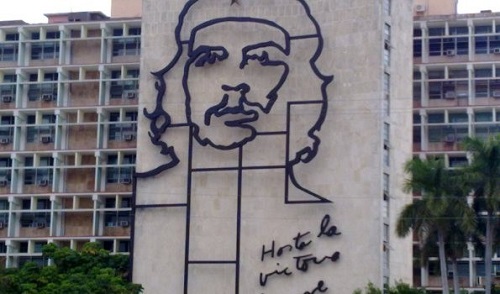|
~ Ernesto Che Guevara
~ Galéria
~ Oldal
~ Bejelentkezés
~ Vissza a Főoldalra
Ernesto Che Guevara, az argentin származású forradalmár, miniszter, gerillavezér és író, Buenos Aires-ben szerzett orvosi diplomát, majd a kubai forradalom során jelentős szerepet játszott a szigetország felszabadításában és újjáépítésében. A kubai gazdaság talpraállításáért dolgozott, küzdött az oktatás és az egészségügy fejlesztéséért, az írástudatlanság és a faji előítéletek felszámolásáért. Saját példájával népszerűsítette az önkéntes munkát. Kongóban és Bolíviában is harcolt - harminckilenc éves volt, amikor az amerikai-bolíviai csapatok csapdába ejtették és kivégezték.
| | |
|

| | |
|
|
|
Cuba: Castro, Cigars and Cuba Libres
|

|
|
It has never been more pressing to visit the Caribbean island of Cuba. Travellers need to experience the country in its current unique state, before its doors open to capitalism and the bulldozers and coca-cola advertisements.
Stepping into Havana was like stepping back into the 1950s. Cuba’s capital city is suffering, or celebrating, an on-going time warp. The crumbling building facades and uneven road surfaces are just some of the very evident pointers that Cuba is a country falling into an undeniable need of repair.
Yet the city is wonderful. 1950s Cadillacs cruise the roads, acting as taxis for tourists and locals alike. The city is full of life and colour, with every bar playing live Cuban music to the casual drinkers who sit and watch the heat rise from the tarmac. The people are wonderfully laid back and offer you Romeo Y Julieta or Cohiba cigars from one of the local factories. There’s also salsa dancing in the streets and the backstreet bars. I had a lesson when I was there, and I was, quite frankly, appalling.
Aside from the vibrancy of Havana, there is a variety of sights and things to do across Cuba. The country conforms to the necessary checklist for all Caribbean islands; the beaches are perfect. I’m not talking April mornings off the coast of Wales with icy waters and seagulls, I’m talking white sands and shimmering sea that runs into the sky, which stays bright until ruined by glorious sunsets.
Cuba’s variety continues when you look at the country’s history. The island still reveres the revolutionary Che Guevara. His picture is plastered everywhere, shops sell postcards of him and there’s a museum dedicated to his life. The visitor attraction explains how he helped Castro liberate Cuba from Batista’s dictatorial rule; the leader who allowed the Americans to use Cuba as its ‘playground’ back in the 50s. It’s not just Guevara’s face that is drawn all over Havana, the streets are also covered in beautiful street art.
The country’s crumbling nostalgia continues largely due to the ongoing embargo imposed by the USA, whose frosty relationship resulted from the Cold War’s Cuban Missile Crisis of 1962. Raul Castro, Cuba’s leader, has begun to allow change. His country is beginning to allow privatisation and trade, although socialism is still prevalent. The ration cards, for example, ensure all people have basic access to food at reduced prices, a Cuban arrangement that celebrated its fiftieth anniversary last year.
However, the poverty in the country is clear. I can’t help but feel that now is the time to visit, before Cuba becomes westernised any further.
Experience the country in its current unique state, before its doors open to America. The time has never been more pressing to visit.
[Source]
|
|
|


| | |
|
|
|
~ Ernesto Che Guevara
~ Gallery
~ Site
~ Log in
~ Back to the Main page
Ernesto Che Guevara, the Argentine-born revolutionary, minister, guerrilla leader and writer, received his medical degree in Buenos Aires, then played an essential part in the Cuban Revolution in liberating and rebuilding the country. He did his best to set up the Cuban economy, fought for the improvement of the education and the health system, the elimination of illiteracy and racial prejudice. He promoted voluntary work by his own example. He fought in the Congo and in Bolivia - he was thirty-nine years old, when he was trapped and executed by the joint American-Bolivian forces.
| | |
|
|

